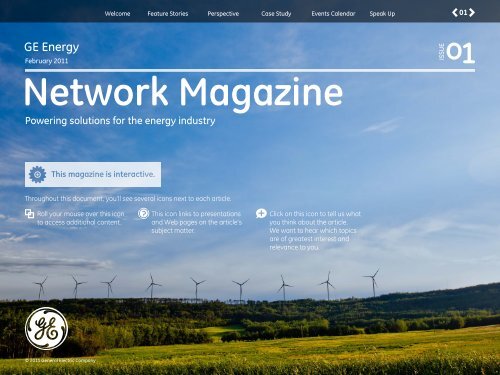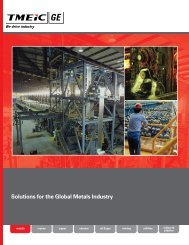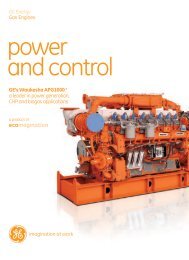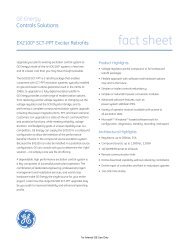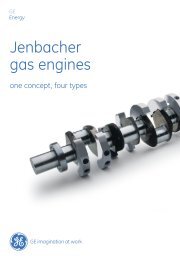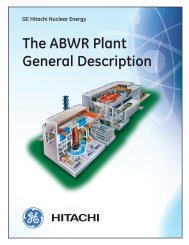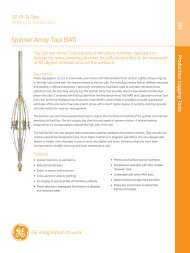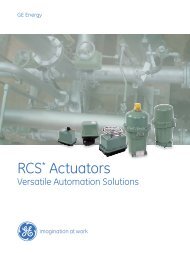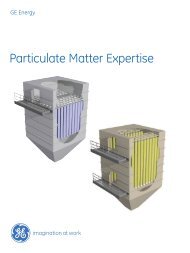Network Magazine - GE Energy
Network Magazine - GE Energy
Network Magazine - GE Energy
- TAGS
- www.ge-energy.com
Create successful ePaper yourself
Turn your PDF publications into a flip-book with our unique Google optimized e-Paper software.
<strong>GE</strong> <strong>Energy</strong><br />
February 2011<br />
<strong>Network</strong> <strong>Magazine</strong><br />
Powering solutions for the energy industry<br />
Throughout this document, you’ll see several icons next to each article.<br />
Roll your mouse over this icon<br />
to access additional content.<br />
© 2011 General Electric Company<br />
This icon links to presentations<br />
and Web pages on the article’s<br />
subject matter.<br />
Click on this icon to tell us what<br />
you think about the article.<br />
We want to hear which topics<br />
are of greatest interest and<br />
relevance to you.<br />
issue<br />
01
© 2011 General Electric Company<br />
Welcome to the inaugural issue of <strong>Network</strong> <strong>Magazine</strong>. We’re pleased to bring<br />
you timely, relevant articles that help you see your energy projects through to<br />
completion and grow your business. Throughout this magazine, you’ll discover<br />
energy service providers are achieving new heights of success through collaboration<br />
with <strong>GE</strong> <strong>Energy</strong>.<br />
One energy sector that promises continued growth is<br />
wind generation. Canada has made a strong regulatory<br />
commitment to renewable energy, and several states<br />
in the United States have passed legislation to begin<br />
aggressively integrating renewables. With a plurality<br />
of citizens from both major American parties in favor<br />
of adding wind power capacity, and 5,500 MW under<br />
construction in the United States alone, we forecast a<br />
robust future for wind power in North America.<br />
We’re proud to help our customers find answers to the<br />
energy industry’s toughest challenges. We hope this<br />
digital magazine will serve as both a conduit for information<br />
and a forum for dialogue. Toward that end, we invite<br />
you to join the conversation. We welcome your input.<br />
For more than 80 years, <strong>GE</strong> <strong>Energy</strong> has provided<br />
innovation, partnership, and leadership on energy<br />
issues. We’re confident that you’ll find <strong>Network</strong> to be<br />
another vital resource for your project planning and<br />
execution needs.<br />
Sincerely,<br />
Bill Jayne Bob Prantil Barry Weiss<br />
<strong>GE</strong> <strong>Energy</strong> Region Executives<br />
02
feature story<br />
Shifting Trends in Power Generation<br />
Predicting power plant retirements is a lot like predicting the weather. Both are<br />
based on highly complex models, include lots of assumptions, and are notoriously<br />
inaccurate beyond the near term. Still, given the potential impact of retirement,<br />
preparation is important, if not essential.<br />
Many states and provinces have passed or are<br />
considering mandates that will shift their populations<br />
away from using fossil fuels for power generation. The<br />
EPA’s proposed rules require retiring or retrofitting 900<br />
MW of coal generation, and may lead to further retirements<br />
due to economic considerations. Older, smaller<br />
units will be most affected by these changes, with gas<br />
and oil, steam, and single-cycle gas turbine units<br />
projected to comprise up to 70 percent of retirements.<br />
© 2011 General Electric Company<br />
Shifting Trends in Power Generation<br />
The foreseeable future, however, is murky beyond<br />
2015. Since retirements are often announced with<br />
little notice, actual numbers could be higher than<br />
projected. Now, more than ever, customers need a<br />
reliable, experienced partner like <strong>GE</strong> to support their<br />
needs through this time of uncertainty.<br />
Greater Emphasis on Flexibility<br />
The remaining thermal units will see a shift in demand,<br />
with a reduced need for true baseload operation<br />
and a higher demand for cyclical operation — a shift<br />
that <strong>GE</strong> <strong>Energy</strong> is prepared to meet. As renewable<br />
energy generation expands, <strong>GE</strong> offers several solutions Sources:<br />
to help integrate renewables into the generation mix. * http://www.duke-energy.com/pdfs/Slides_021610.pdf<br />
The changing resource mix will further emphasize<br />
** http://blogs.wsj.com/environmentalcapital/2009/12/<br />
the need for flexibility in both operational and<br />
09/clean-coal-aep-ups-expectations-for-carbon-capture-<br />
expansion strategies.<br />
and-storage/<br />
“As a result of carbon capture,<br />
AEP will be able to retire 25%<br />
of its coal-burning power<br />
plants and install advanced<br />
carbon-capture equipment<br />
on the remaining 75%.”<br />
- Mike Morris, Chairman, President,<br />
and Chief Executive Officer, AEP**<br />
Learn more about<br />
the solutions:<br />
• Heavy Duty Gas Turbines<br />
• Steam Turbines<br />
• Aeroderivatives<br />
• Generators<br />
• Controls<br />
• Alterrex <br />
• Plant Design and Optimization Services<br />
• Remote Services<br />
03
feature story<br />
Solutions for Integrating Renewables<br />
Learn more about the solutions:<br />
• Smart Grid Augmented Reality Solar Game<br />
•”Rays” TV Ad<br />
• Wind Services Brochure<br />
• Renewable <strong>Energy</strong> Solutions<br />
© 2011 General Electric Company<br />
Solutions for Integrating Renewables<br />
Integrating renewable energy from wind, solar and biogas into the North<br />
American grid is no easy challenge. It’s a complex process requiring foresight,<br />
planning, and cooperative decision-making among many stakeholders. It also<br />
requires a partner with the technical expertise to manage the volatility<br />
inherent in renewables integration.<br />
Renewables are highly variable over a variety of<br />
timescales. Wind power strength can vary by the<br />
minute; solar energy varies from day to day; and<br />
both are variable from season to season. <strong>GE</strong> <strong>Energy</strong><br />
offers a suite of tools to manage power over each<br />
timescale, from second-to-second, hour-to-hour,<br />
and for planning up to a week ahead.<br />
Flexibility is critical; that’s why <strong>GE</strong> offers a range<br />
of solutions —from Jenbacher gas engines to<br />
aeroderivatives.<br />
Software Solutions to Address<br />
Renewables Integration<br />
<strong>GE</strong>’s Positive Sequence Load Flow (PSLF) Software<br />
provides comprehensive load flow, dynamic simulation<br />
and short-circuit analysis. Using this tool, engineers<br />
can analyze transfer limits while performing<br />
economic dispatch. The software is ideal for simulating<br />
the transfer of large blocks of power across<br />
a transmission grid or to neighboring systems. It<br />
includes detailed dynamic models of <strong>GE</strong>’s doubly fed<br />
and full converter wind turbine generators, as well as<br />
a <strong>GE</strong> PV solar plant model.<br />
04<br />
<strong>GE</strong>’s MAPS Software helps utilities plan ahead<br />
by modeling market dynamics hour-by-hour. This<br />
tool provides valuable insight into regional power<br />
markets, which are defined by physical transmission<br />
limits. MAPS models the electrical system in detail,<br />
examining the flow on each line for every hour of<br />
the simulation, identifying both normal and securityrelated<br />
transmission constraints. By providing a<br />
more accurate picture, MAPS helps improve utilities’<br />
bottom lines.<br />
One of the key drivers that can accelerate<br />
renewable integration will be governmental policy<br />
initiatives that incentivize power producers and<br />
consumers to shift toward greater use of clean power—an<br />
issue we examine in greater detail in this issue’s<br />
perspective column by <strong>GE</strong> Vice President Vic Abate.
solutions for integrating renewables<br />
The New 7FA<br />
<strong>GE</strong> has technologies to integrate wind and solar energy when they’re<br />
available, and solutions to compensate with traditional generation<br />
methods when they’re not. The newest iteration of <strong>GE</strong>’s 7FA turbine will<br />
soon be available to address the uncertainty and variability characteristic<br />
of renewable energy integration.<br />
In addition to delivering greater output and efficiency,<br />
its superior operational flexibility makes the 7FA<br />
one of the most reliable turbines ever designed. By<br />
combining a host of technologies from across <strong>GE</strong>’s<br />
product lines, the new 7FA offers improvements in<br />
output, thermal efficiency, and operability, and<br />
lower life-cycle costs, all without compromising the<br />
high degree of reliability historically delivered by<br />
<strong>GE</strong>’s F-class fleet.<br />
The next 7FA offers customers the ability to operate<br />
according to their specific business priorities and<br />
industry parameters, largely free from the constraints<br />
of equipment limitations. It’s also part of <strong>GE</strong>’s<br />
ecomagination portfolio—an assortment of innovative<br />
technologies that help customers address their<br />
environmental and financial needs, such as the need<br />
for cleaner, more efficient sources of energy. In order<br />
to join the ecomagination portfolio, a system must<br />
complete the company’s rigorous internal and thirdparty<br />
environmental and operational evaluation.<br />
The new 7FA is more efficient and capable of higher<br />
output, which will result in less fuel consumption<br />
and lower emissions per MW-hour.<br />
© 2011 General Electric Company<br />
The New 7FA<br />
With <strong>GE</strong>’s 7F fleet already providing more than<br />
15 percent of North American capacity, the balanced<br />
combination of flexibility, reliability, and efficiency<br />
make this offering a smart choice for energy generation.<br />
Manufactured in Greenville, South Carolina,<br />
the 7FA will be available for delivery beginning in<br />
January, 2012.<br />
95.4%<br />
availability<br />
98.4%<br />
starting<br />
reliability<br />
05<br />
99.3%<br />
operating<br />
reliability
feature story<br />
Introducing the J920<br />
Whether you’re seeking full power at high efficiency levels or a unit capable<br />
of short start-up times, <strong>GE</strong>’s J920 power generation gas engine—targeted<br />
for 2012 availability—will be an ideal, reliable solution for your lasting power<br />
needs and grid stabilizing efforts.<br />
<strong>GE</strong>’s J920 Jenbacher gas engine is designed to<br />
achieve the highest electrical efficiency level in its<br />
class, reaching 48.7 percent efficiency. Its unique<br />
design enables high-power density for a lower investment<br />
cost. Two-stage turbocharging technology<br />
allows stable power outputs and efficiency at<br />
high ambient conditions. Additionally, the innovative<br />
modular design allows fast and seamless<br />
installation, with easier maintainability in both<br />
industrialized zones and remote areas. As an<br />
ecomagination-approved innovation, the J920<br />
requires less fuel consumption, thereby reducing<br />
environmental impact and lowering lifecycle costs.<br />
<strong>GE</strong> has been at the forefront of power generation gas<br />
engine technology. With customers in more than<br />
80 countries throughout the world, <strong>GE</strong> offers<br />
multifaceted service capabilities designed to meet<br />
a variety of needs.<br />
Based on our modular plant concept and your<br />
specific requirements, our system engineers guide<br />
you through every critical planning phase, from the<br />
feasibility study to the design and installation.<br />
Our trained project and system engineers offer project<br />
management expertise to support you during<br />
the plant realization phases and our contractual<br />
service agreements provide flexible and optimum<br />
care for your plant during operation. Through our<br />
global service network, you’ll have dedicated personnel<br />
to help ensure predictable operating costs<br />
and risk mitigation.<br />
© 2011 General Electric Company<br />
With the introduction of the J920, <strong>GE</strong> is the only gas<br />
engine manufacturer currently offering small and<br />
large gas engines. The J920 also offers the highest<br />
electrical efficiency in its class, with an electrical output<br />
of 8.55 MW available from the 60 Hz unit.<br />
Introducing the J920<br />
Features and Benefits:<br />
• High power density at low investment costs<br />
• Top in its class electrical efficiency level<br />
of 48.7%<br />
• Stable power output and efficiency at high<br />
ambient conditions<br />
• Quick start-up for grid stabilization<br />
• Fast and easy installation<br />
• Designed for ease of maintainability<br />
• Full plant flexibility with any multiple-engine<br />
installation<br />
• Combined heat and power solution with<br />
90 percent efficiency<br />
06
perspective<br />
The Case for National Renewable <strong>Energy</strong> Standards<br />
By Vic Abate<br />
<strong>GE</strong> <strong>Energy</strong> Vice President, Renewables<br />
President, American Wind<br />
<strong>Energy</strong> Association 2010-2011<br />
© 2011 General Electric Company<br />
The wind industry in the United States is at a crossroads. The outlook for new<br />
projects is under pressure due to reduced power demand, lower natural gas prices,<br />
transmission challenges, and the lack of a long-term renewable energy policy.<br />
China and Europe, on the other hand, are each<br />
projected to realize robust annual installations of<br />
more than 10 GW for the next decade because they’ve<br />
adopted long-term renewable policies. The United<br />
States needs federal policy to drive demand for<br />
renewable energy in general, and for wind power,<br />
in particular.<br />
Without a strong national policy, annual wind<br />
installations in the United States will likely drop 50<br />
percent from numbers reported in 2009—with a<br />
corresponding loss of manufacturing and industryrelated<br />
jobs. Fortunately, we can avert stagnation<br />
if we act quickly. A recent study by Navigant<br />
Consulting concludes that the United States could<br />
create 266,000 new jobs if it adopts a proposed<br />
national renewable energy standard (RES) that could<br />
generate 25 percent of its power from renewable<br />
sources by the year 2025.<br />
As an industry, we’ve made tremendous progress.<br />
Investment and innovation in advanced wind<br />
technol ogies has resulted in more efficient wind<br />
farms with higher reliability. We have the technology<br />
to help decrease our dependence on foreign energy<br />
sources, increase national security, and preserve<br />
the environment. Together, the energy industry<br />
is poised to help the United States renew its manufacturing<br />
sector and create jobs if Congress passes<br />
a national RES.<br />
As we witnessed during <strong>GE</strong>’s 28-day Capture the<br />
Wind Blade Tour from Aberdeen, South Dakota, to<br />
Dallas, Texas, there is strong public support for wind<br />
energy across the country. Thousands of people<br />
from all walks of life saw the wind blade up close<br />
and signed their names on this travelling petition in<br />
support of America’s clean energy future.<br />
We look forward to working together with policymakers<br />
to ensure a better energy future for<br />
generations to come.<br />
07
case study<br />
Transforming<br />
Waste to <strong>Energy</strong><br />
using <strong>GE</strong>’s Gas<br />
Engine Technology<br />
© 2011 General Electric Company<br />
In Catawba County, North Carolina, a unique initiative is gaining attention for<br />
turning industrial waste into energy. On a 1,000-acre site near Charlotte, Gregory<br />
Wood Products, Pallet One, Inc., Appalachian State University, and other local<br />
businesses have formed a cooperative to recycle each other’s by-products into energy<br />
to power their own manufacturing processes. At the heart of this EcoPlex sits<br />
the Blackburn Landfill, which has produced energy from methane for more than a<br />
decade using <strong>GE</strong>’s Jenbacher gas engines.<br />
Since 1999, the Jenbacher gas engines at the<br />
EcoPlex’s Landfill Gas-to-<strong>Energy</strong> Facility have transformed<br />
the landfill’s waste gas into enough electricity<br />
to power about 1,400 homes. With approximately<br />
650 tons of waste entering the landfill each day, the<br />
EcoPlex’s potential to produce electricity will<br />
continue to grow.<br />
The EcoPlex serves as a laboratory for several<br />
environmentally friendly business practices. Lumber<br />
scraps from Gregory Wood Products are used by<br />
Pallet One, Inc. to construct shipping pallets; and<br />
wood shavings, bark, and sawdust will be used in a<br />
planned bio-energy facility, That facility will double<br />
the EcoPlex’s current waste-to-energy capabilities<br />
using Jenbacher engines and a biomass gasification<br />
system. Sunflower and canola are cultivated<br />
in the buffer acreage that surrounds the landfill, and<br />
construction is underway on a biodiesel research<br />
facility where students from Appalachian State University<br />
will experiment with biodiesel produced from<br />
those crops.<br />
<strong>GE</strong> is proud to collaborate with its fellow stakeholders<br />
in North Carolina, and hopes that the EcoPlex<br />
can serve as a continental model of successful<br />
conservation.<br />
“<strong>GE</strong> <strong>Energy</strong> and its associated<br />
resources are qualified to meet<br />
our needs, both today and in the<br />
future. Not only does <strong>GE</strong> share<br />
our commitment to protecting the<br />
environment, but the company<br />
also has engaged in research and<br />
planning activities to further the<br />
development of the EcoComplex,<br />
and help us deliver on that<br />
commitment.”<br />
– Barry Edwards, Catawba County<br />
Director of Utilities and Engineering<br />
Introducing the new J920<br />
Jenbacher gas engine<br />
• In This Issue<br />
• Visit Our Web Page<br />
08
2011 North America<br />
Events Calendar<br />
Calendar is subject to change<br />
1Q<br />
Distributech San Diego, CA<br />
7FA.05 Compressor/Test Stand Customer Event Greenville, SC<br />
<strong>Energy</strong> Generation Conference Bismarck, ND<br />
Oil & Gas Technology Summit Houston, TX<br />
<strong>Energy</strong> Utility and Environment Conference Phoenix, AZ<br />
<strong>Energy</strong> Technology Seminar Weehawken, NJ<br />
Medical Design & Manufacturing West Anaheim, CA<br />
Mining, Metallurgy and Exploration Conference Denver. CO<br />
2Q<br />
Offshore Technology Conference Houston, TX<br />
Food Automation and Manufacturing Palm Beach, FL<br />
AWEA Windpower Anaheim, CA<br />
BevTech Ft. Lauderdale, FL<br />
APPA National Conference & Public Power Expo Washington, DC<br />
Syngas Association Annual Conference Tulsa, OK<br />
Offshore Technology Conference Houston, TX<br />
© 2011 General Electric Company<br />
3Q<br />
International Dairy Association Atlanta, GA<br />
Intersolar San Francisco, CA<br />
Renewable <strong>Energy</strong> Technology Conference Washington, DC<br />
Hydrovision Sacramento, CA<br />
Oil Sands & Heavy Oil Technologies Calgary, Alberta, Canada<br />
CoalGen Columbus, OH<br />
Oil Sands Trade show and Conference Ft. McMurray, Alberta,<br />
Canada<br />
4Q<br />
ChemShow New York, NY<br />
CanWEA Vancouver, British<br />
Columbia, Canada<br />
Solar Power International Dallas, TX<br />
60Hz Tech Symposium Houston, TX<br />
International Water Conference Orlando, FL<br />
WEFTEC Los Angeles, CA<br />
09
© 2011 General Electric Company<br />
speak up<br />
We want to hear from you.<br />
<strong>GE</strong> <strong>Energy</strong> is committed to helping our customers. We’d like<br />
to make sure your voice is part of the <strong>Network</strong> conversation.<br />
If you have a question or a business challenge to overcome,<br />
consider letting us help you through one of the channels<br />
below.<br />
Ask the Expert<br />
Our team of subject matter experts stands ready to provide answers to your<br />
queries. Please send in your question, along with your contact information.<br />
Solve my Problem<br />
Take advantage of <strong>GE</strong>’s vast array of operational experience by letting us solve<br />
your toughest challenges. Please describe your challenge, and include your<br />
contact information so that we can get in touch with you and your team.<br />
To submit questions or topics for any<br />
of the above channels, please<br />
contact us.<br />
10<br />
For the latest news on <strong>GE</strong> <strong>Energy</strong>’s<br />
products, services, and events, please<br />
visit our home page.


